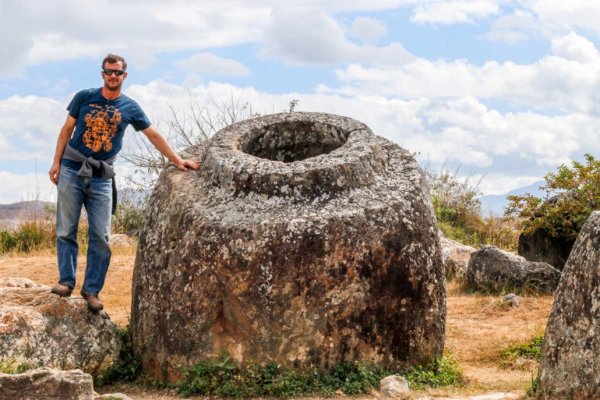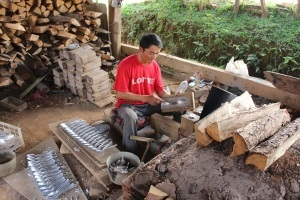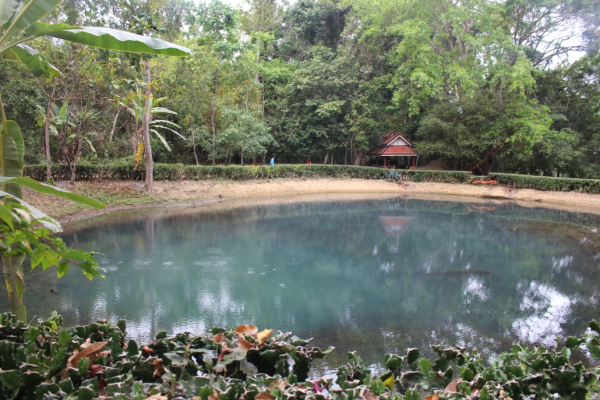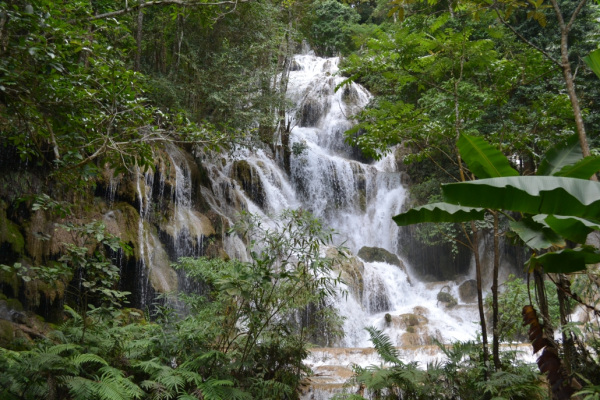Located 400 kilometers northeast of Vientiane Capital, Xieng Khouang Province is on the mountainous Tran-ninh plateau. It is set at an altitude of more than 1,000 metres above sea level and enjoys mild temperatures for most of the year, although winters can be surprisingly cold. Kham District is a low-lying basin set at around 600 meters above sea level.

The province shares borders with Houaphanh, Luang Prabang, Vientiane and Bolikhamxay provinces, as well as an international border with Vietnam. Xieng Khouang has a long and rich history and is home to numerous ethnic groups, including Thai Phuan, Hmong, Khmu, Erdu, Phong and Tai.
Until briefly after World War II, the French used Xieng Khouang Town, present-day Muang Khoun town, as their provincial capital. A few ruinous colonial public buildings remain to this day, such as the governor’s residence, church and French school.
Phonsavanh, the new provincial capital, is located in Paek District and caters to increasing numbers of national and international tourists, eager to experience Xieng Khouang’s natural, historical and archaeological attractions. The new airport in Phonsavanh is served by regular flights from Vientiane Capital by Lao Airlines.

Plain of Jars
The Plain of Jars, prehistoric stone megaliths, attract thousands of tourists to the province each year. The area is of significant archaeological importance on account also of the Standing Stones of Hintang in nearby Houaphanh Province.
Prehistoric material found at the Plain of Jars is still under study, and apparently spans a considerable period of time, with some dating from as early as 2000 BC. The bulk of the archaeological material, however, as well as the jars themselves appeared much later, dating to the early Iron Age between 500 BC and 500-800 AD.
Although little is known about the people that constructed the megalithic stone jars, an account of the area’s history is recorded in the Muang Puan Chronicles. The Tai Puan are a Buddhist Tai-Lao ethnic group that migrated from what is today southern China and by the 13th century had formed an independent principality at the Plain of Jars that prospered from the overland trade in metals and forest products.
During the Second Indochina War that raged in Laos during the 1960’s and early 1970’s Xieng Khouang suffered heavy aerial bombardment and intense ground battles due to its strategic importance. This conflict has left a deadly legacy of unexploded ordnance (UXO) which is still being cleared today. Since Laos gained full independence in 1975, Xiengkhouang and the Plain of Jars are enjoying peace and tranquility after centuries of conflict.
The original capital city, Muong Khoun, was almost totally obliterated by US bombing and consequently, the capital was moved to nearby Phonsavanh. Of several Muong Khoun Buddhist temples built between the 16th and 19th century, only ruins remain. Vat Pia Vat, however, survived the bombing and can be visited.
Be sure to visit the Xieng Khoung Provincial Museum to explore the intriguing history of this area.
Tourist Destination
Plain of Jars

Plain of Jars
The Plain of Jars is considered the most distinctive and enigmatic of all Laos attractions. The large area around Phonsavan, the main city of Xieng Khouang Province is dotted with stone jars but no one has a clear idea as to why they are there. The mysterious jars were carved from both sandstone and granite in various sizes from very small to about 3.5 metres high and are thought to be more than 2,000 years old. Legend has it that they were made to store rice wine while some believe they were for storing the dead. Until today the function of the jars is still disputed. Of all the many jar sites, the three most popular ones to visit are known as Site 1, 2 and 3. The main reason is because they are safe from UXO (unexploded ordinance). Still, visitors are advised to walk only on the known routes as Laos is considered the most heavily bombed/ mined country in the world. During the Vietnam War this area got hit hard and some of the bombs did not go off. Site 1 is where the biggest jar is located. While Site 2 and 3 offer picturesque views of farmlands and villages as they sit on top of small hills. Location: Around Phonsavan, the main town of Xieng Khouang Province in Northeast Laos. Site 1 is about 15km southwest of Phonsavan and has about 300 jars. Site 2 is about 25km south of Phonsavan and contains about 90 jars spread over two hills. Site 3 is about 35km southeast of Phonsavan and contains about 150 jars. It’s actually only 10km away from Site 2 It’s easy to hire taxi (4WD and driver) from Phonsavan to the jar sites or visitors can catch a local bus to Site 3 but not site 1 and 2.
Jar site 1 or Tong Hai Hin is the most popular site, located 8 km southwest of Phonsavanh and by easily reached by tuk tuk or bike. Follow Rt 1D southwest, turn right the sight Ban Na-O and dive for another 2 kilometer; alternatively book a package tour at any of the local tour companies.
 Plain of Jars
Plain of Jars
The site counts 334 jars, including the largest single jar-side to have been the victory cup of the King Khoun Chueang. According to local legend the Lao King Khoun Chueang (AD 6th century) fought a long battle against his enemy and liberated the local people from the oppressive ruler. The Jars were carved to brew and store huge amounts of Lao Lao which were drunk in the 7 month lasting celebration held in honor of victory.
Jars site 1 was of military strategic important during the second Indochina War. Trenches and foxholes, anti-air-craft positions and tank scrape can be found on the two raised areas and on top of the cave. Several bomb craters and damaged or displaced jar are a testimony to heavy fighting in this area.
A part from a plain of jars, visitor also can visit the sophisticated “War Museum”which was recently built.
Jar Site 2, or Ban Na Kho, is located in Phaxay district, 20 km southwest of Phonsavan. The site contains 93 jars spread across two adjacent hills. Some of the urns at Site 2 are carved with an inner rim just below the lip of the jar.
From the parking area and ticket office, walk up the stairs on your left to the first group. A small plundered stupa can be visited further east on the hill. The date of the stupa is unknown.
The road which bisects the adjacent hills was constructed by the French in the colonial period and was already documented by Madeleine Colani in the early 1930s. On the hill to the west a stone disc has been carved with a human figure and concentric circles. Bomb craters surround the site and several of the stone jars show the impact of ground battles. During French colonial times, Site 2 was a popular pic-nic spot.
It is possible to walk from Site 2 to Site 3 by following a narrow path that has been cleared of UXO. As you approach Site 3, you will come across a group of jars, believed to be jars in transit from Huay Luang, the quarry that provided the sandstone for the jars at Sites 2 and 3.

Jar Site 3, or Ban Xieng Di (also known as Hai Hin Lat Khai), is made up of seven groups and is located around the village of Ban Xieng Di, 5 km further south of Site 2, in Phaxay district. As for Site 2, some of the urns at Site 3 are carved with an inner rim just below the lip of the jar. The main group, with some 150 jars, is situated on top of a scenic hill which offers great views of the surrounding plain and rice paddies. To get to the main group, cross the bridge after paying the entrance fee and continue along the rice fields to the lower foothill of the mountain, where a marked path picks up the trail to the site.
The village has a small Buddhist temple near the entrance booth, where visitors are welcome. The small restaurant near the ticket booth serves drinks and noodle soup and is run by a local family. A portion of the restaurant profit goes to the village fund, which benefits the entire community.
The travel agencies in Phonsavan offer tours to Jar Sites 2 and 3, often combined with a visit to the former provincial capital, present-day Muang Khoun town.

Site 21, or Phu Kheng Quarry Site is located in Paek district, 16 km northwest of Phonsavan. The quarry site is well sign-posted on the westbound section of Route 7. The site has been cleared of UXO and was officially opened to tourist visits in January 2012 following improvements in the infrastructure. This important quarry site covers an area of 20 hectares and was the source of sandstone for the jars at Site 1.
Visitors can admire finished and partially-completed jars at every stage of the carving process. According to legend, in 1351 BCE, King Khun Jeuang ruled Mouang Phuan and started to spread his power base. Whenever a battle was won, the king would order his subordinates to make containers for celebratory rice whisky. It is said that the abundant rocks convinced King Khun Jeuang’s men to come to Phu Kheng to carve monolithic jars with simple metal tools. The legend also states that the jars were filled with water and abandoned at the site if they were found to be leaking, because they would not have been able to hold rice whisky for the victorious celebrations. Though local legends are embedded in recorded history, they cannot be confirmed through material evidence.

The Khun Jeuang legend is no exception, for, though it is reported that he lived in the 6th century CE, the material evidence indicates that the jars were present as early as 1000 years before his victory.A recently completed brick staircase at Site 21 leads visitors to a wartime bunker, built during the Second Indochina war. Bedrooms and storage rooms for weapons were built inside the 100-metre long tunnel. An observation tower was also built, to monitor and guard the place. A visit to Phu Kheng offers a rare mix of natural beauty and archaeology, and a chance to experience the ancient and recent history of Xieng Khouang province.
Source:KPL